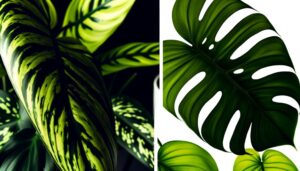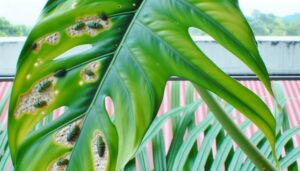Is Monstera Obliqua Toxic to Cats
Yes, Monstera Obliqua is toxic to cats. It contains calcium oxalate crystals, which cause severe oral irritation, excessive drooling, and difficulty swallowing when ingested.
These crystals embed in your cat's tissues, leading to intense pain and inflammation. Immediate action includes removing plant material from your cat's mouth, rinsing it out, and monitoring symptoms closely.
It's essential to contact a veterinarian if symptoms persist or worsen. Consider safer plant alternatives like spider plants or Boston ferns to prevent future incidents.
For more on ensuring your home is cat-safe and which plants to avoid, continue on.
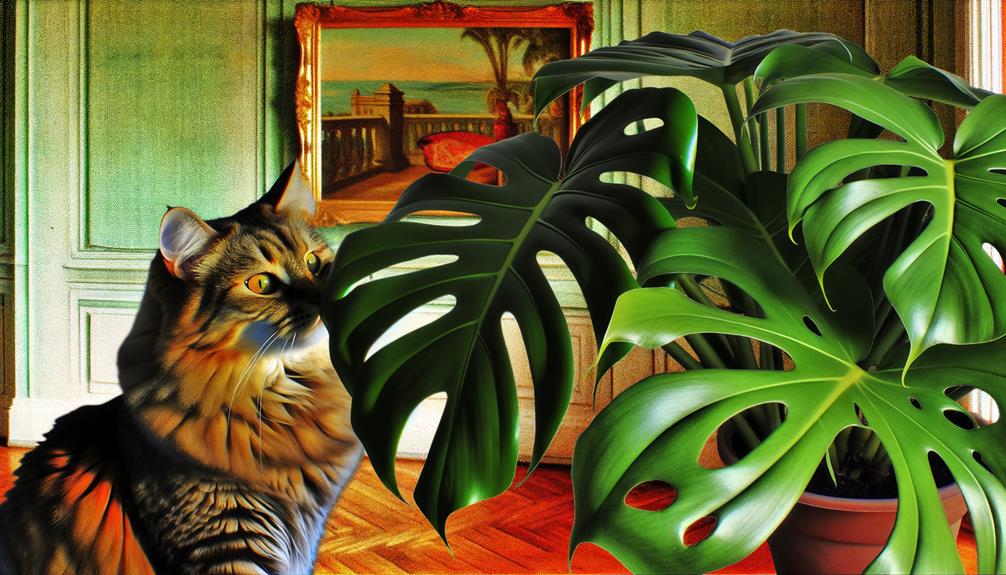
Key Takeaways
- Monstera Obliqua is toxic to cats.
- Ingesting Monstera Obliqua causes oral irritation and difficulty swallowing.
- The plant contains calcium oxalate crystals, leading to intense pain and inflammation.
- Symptoms include excessive drooling, vomiting, and difficulty swallowing.
- Remove plant material and rinse the cat's mouth immediately if ingested.
Understanding Monstera Obliqua
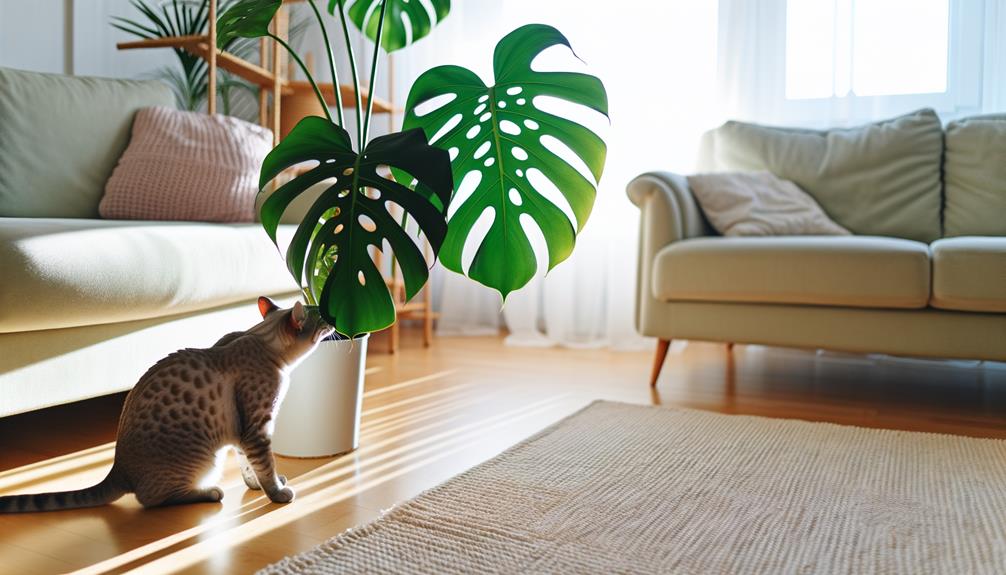
Monstera obliqua, a rare and highly sought-after species in the plant enthusiast community, is characterized by its delicate, fenestrated leaves and slow growth rate. You'll find that its unique morphology, featuring extensive perforations and thin leaf structure, distinguishes it from other Monstera species.
This plant thrives in high humidity environments and requires indirect light to prevent leaf scorching. Evidence suggests that its slow growth is due to its limited chlorophyll content, necessitating precise care for best health. Root systems are typically shallow, making well-draining soil essential to avoid waterlogging.
With proper care, Monstera obliqua can be a stunning addition to your collection, though its rarity often results in higher acquisition costs. Understanding these factors guarantees successful cultivation.
Toxicity Levels in Plants
Understanding the toxicity levels in common houseplants is essential for ensuring your cat's safety. Toxic plants can cause symptoms ranging from mild gastrointestinal distress to severe organ failure.
Opt for cat-safe alternatives like spider plants or Boston ferns to mitigate these risks.
Common Toxic Houseplants
Houseplants like Dieffenbachia, Philodendron, and Pothos contain toxic compounds that can pose serious health risks to cats. Dieffenbachia, commonly known as dumb cane, has calcium oxalate crystals, which cause oral irritation and swelling.
Philodendron species also contain these crystals, leading to similar symptoms. Pothos, or Devil's Ivy, contains insoluble raphides that can result in severe oral pain and gastrointestinal distress. Even minimal ingestion can cause significant discomfort.
It's essential to recognize the specific toxic agents in these plants to mitigate risks effectively. By understanding the toxicology of these common houseplants, you can make informed decisions about the flora in your home, ensuring your feline companions are safe from potential harm.
Symptoms of Plant Toxicity
When a cat ingests a toxic plant, symptoms can range from mild gastrointestinal upset to severe systemic reactions depending on the plant's toxicity level. Clinical signs include vomiting, diarrhea, lethargy, and even organ failure. Understanding these symptoms is essential for timely intervention.
| Symptom | Description |
|---|---|
| Gastrointestinal | Vomiting, diarrhea, drooling |
| Neurological | Tremors, seizures, ataxia |
| Cardiovascular | Arrhythmias, hypotension |
| Respiratory | Dyspnea, coughing, wheezing |
| Renal | Polyuria, anuria, renal failure |
Recognizing these clinical manifestations early allows for prompt veterinary care, potentially mitigating severe outcomes. Evidence suggests that immediate treatment can markedly improve prognosis. Always monitor your cat closely if you suspect they've ingested a harmful plant.
Safe Alternatives for Cats
Given the potential dangers of plant toxicity, it's crucial to explore safer alternatives that won't pose a risk to your feline friends.
Opt for non-harmful species such as Spider Plants (Chlorophytum comosum), which are known to be secure and even beneficial due to their air-purifying properties.
Catnip (Nepeta cataria) is another excellent choice, providing both a secure environment and stimulating activity for your cat.
Boston Ferns (Nephrolepis exaltata) are also non-poisonous and add lush greenery to your home without compromising your pet's safety.
Always cross-reference plant species with reliable sources such as the ASPCA's toxic and non-poisonous plant list to secure their safety.
Effects on Cats
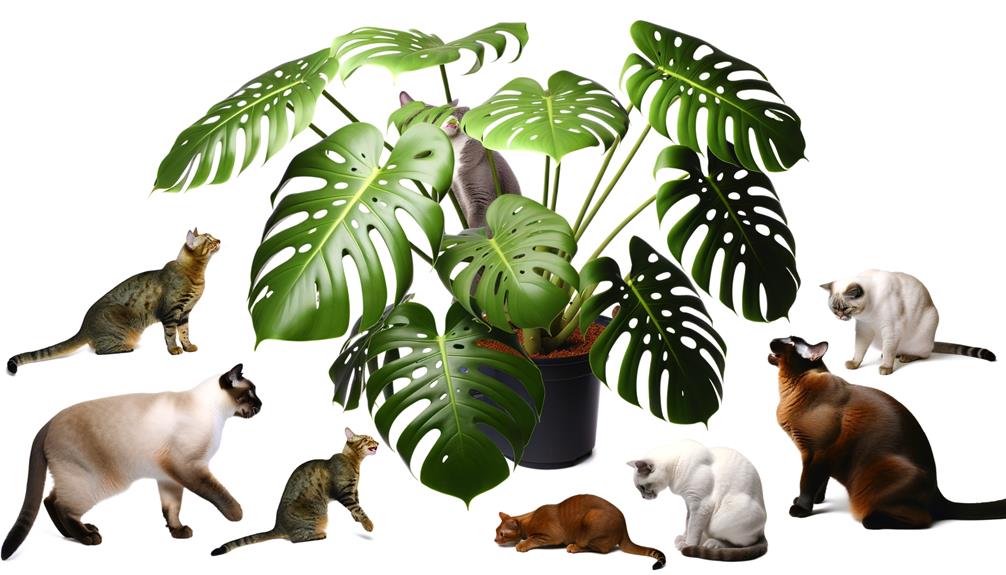
Ingesting Monstera obliqua can cause significant oral irritation, excessive drooling, and difficulty swallowing in cats due to its insoluble calcium oxalate crystals. These microscopic crystals embed themselves in the mucous membranes, leading to intense pain and inflammation.
When your cat chews on the plant, the crystals are released, causing immediate discomfort. This reaction is a defense mechanism of the plant, discouraging herbivory.
The severity of the effects can vary based on the amount ingested and the individual cat's sensitivity. You should always monitor your pet closely if exposure is suspected. Rapid veterinary intervention can mitigate complications and provide relief.
Understanding these effects can help you make informed decisions about plant choices in your home.
Symptoms of Poisoning
You may notice symptoms such as oral irritation, excessive drooling, vomiting, and difficulty swallowing if your cat has ingested Monstera obliqua. These signs stem from the plant's calcium oxalate crystals, which can embed themselves in your cat's oral and gastrointestinal tissues.
Oral irritation may present as pawing at the mouth or face. Excessive drooling, known as ptyalism, often accompanies the irritation. Vomiting and difficulty swallowing (dysphagia) indicate more severe gastrointestinal distress.
These symptoms are your cat's physiological responses to the plant's toxic components. Monitoring these clinical signs can provide essential information for your veterinarian, aiding in diagnosis and treatment. Recognizing these symptoms promptly will help you understand the severity of the situation and prepare for necessary interventions.
Immediate Actions to Take
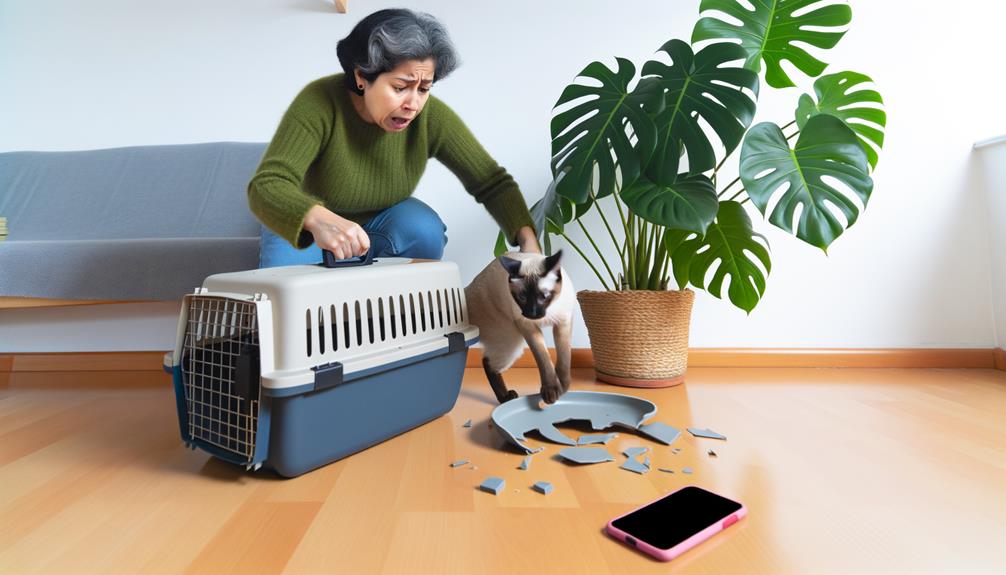
Promptly remove any plant material from your cat's mouth to prevent further ingestion and minimize toxicity.
Rinse your cat's mouth with water to remove any remaining plant residue.
Monitor your cat closely for symptoms such as drooling, vomiting, or difficulty swallowing.
Isolate your cat from the Monstera obliqua to prevent further exposure.
Offer fresh water to encourage hydration, as this can help dilute ingested toxins.
Avoid inducing vomiting, as this can exacerbate symptoms and cause additional harm.
It's essential to maintain a calm environment to reduce your cat's stress levels.
Quickly gather any information about the plant and potential ingestion, including the amount consumed, to prepare for further medical consultation.
Consulting a Veterinarian
Contact your veterinarian immediately to discuss the potential toxicity and receive tailored advice based on your cat's symptoms and the amount of Monstera obliqua ingested.
A veterinarian will evaluate the situation and may recommend the following:
- Clinical examination: Assess your cat's essential signs and overall health.
- Diagnostic tests: Blood work and imaging to identify any internal damage.
- Gastrointestinal decontamination: Inducing vomiting or administering activated charcoal to limit toxin absorption.
- Fluid therapy: Intravenous fluids to maintain hydration and support renal function.
- Symptomatic treatment: Medications to manage nausea, pain, or other symptoms.
Prompt veterinary consultation ensures your cat receives appropriate care. Early intervention can mitigate severe complications, enhancing your pet's prognosis.
Always follow your vet's guidance to guarantee the best outcome for your feline friend.
Pet-Safe Alternatives
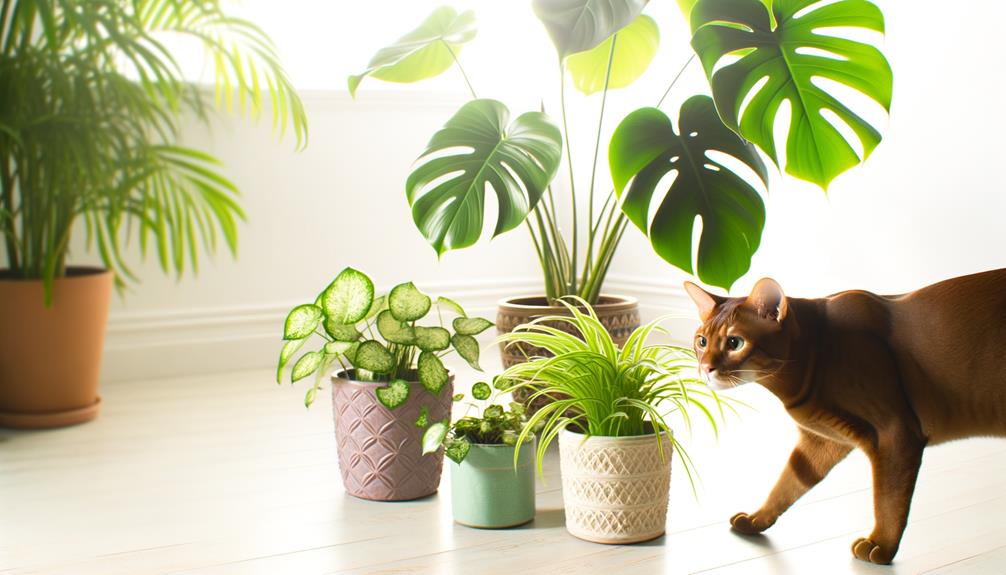
For a safer environment, consider incorporating non-toxic plants such as spider plants, Boston ferns, or cat grass, which provide aesthetic appeal without posing a risk to your cat's health.
Spider plants (Chlorophytum comosum) are resilient and known for their air-purifying properties.
Boston ferns (Nephrolepis exaltata) thrive in similar conditions to many toxic houseplants but are safe for pets.
Cat grass (Dactylis glomerata) not only enhances indoor greenery but also offers nutritional benefits when ingested by cats.
These alternatives are backed by clinical evidence indicating their safety for feline companions. Including these plants in your home maintains a harmonious balance between decor and pet safety, ensuring you don't compromise on either aspect.
Preventing Future Incidents
To prevent future toxic exposures, identify and introduce safe plant alternatives like spider plants or Boston ferns.
Implement cat-friendly home strategies, including placing toxic plants out of reach and providing engaging toys.
These measures reduce the risk of poisoning and guarantee a safe environment for your feline companion.
Safe Plant Alternatives
Considering your cat's health, it's essential to choose non-toxic plants like spider plants and Boston ferns to prevent any future incidents of poisoning. These plants aren't only safe but also beneficial for indoor air quality. By selecting pet-safe foliage, you're lessening the risk of toxic exposure and ensuring a safer environment for your feline companion.
Here are some recommended non-toxic plants:
- Spider Plant: Chlorophytum comosum, known for its air-purifying abilities.
- Boston Fern: Nephrolepis exaltata, which adds humidity to the room.
- Areca Palm: Dypsis lutescens, a resilient, cat-safe option.
- Calathea: Calathea spp., admired for its striking leaf patterns.
- Ponytail Palm: Beaucarnea recurvata, a low-maintenance plant.
Incorporating these plants into your home notably diminishes the risk of poisoning, promoting a safer and healthier living space for your cat.
Cat-friendly Home Tips
Ensuring a cat-friendly home involves meticulous planning and the implementation of preventive measures based on evidence-based practices to avert potential health hazards.
First, remove or secure all toxic plants, including Monstera Obliqua, utilizing elevated shelves or hanging baskets. Regularly inspect your home for potential hazards, ensuring that small objects or chemicals are stored securely. Utilize cat-friendly plants like spider plants and Boston ferns to maintain a safe environment. Implement deterrents like bitter sprays on furniture and electrical cords to prevent chewing.
Additionally, provide engaging toys and scratching posts to mitigate boredom-induced behaviors. Always consult your veterinarian for personalized advice tailored to your cat's specific needs, ensuring a thorough approach to maintaining a safe and enriching home environment.
Conclusion
Essentially, while the Monstera obliqua may evoke the charm of Pandora's box with its enchanting appearance, it's vital to remember its toxic potential for your feline companions. Recognizing symptoms like drooling, oral irritation, and vomiting can be pivotal.
Immediate action and veterinary consultation are paramount. Opt for pet-safe alternatives to guarantee a harmonious coexistence.
By staying vigilant, you can protect your furry friend from the dangers of this alluring plant.


